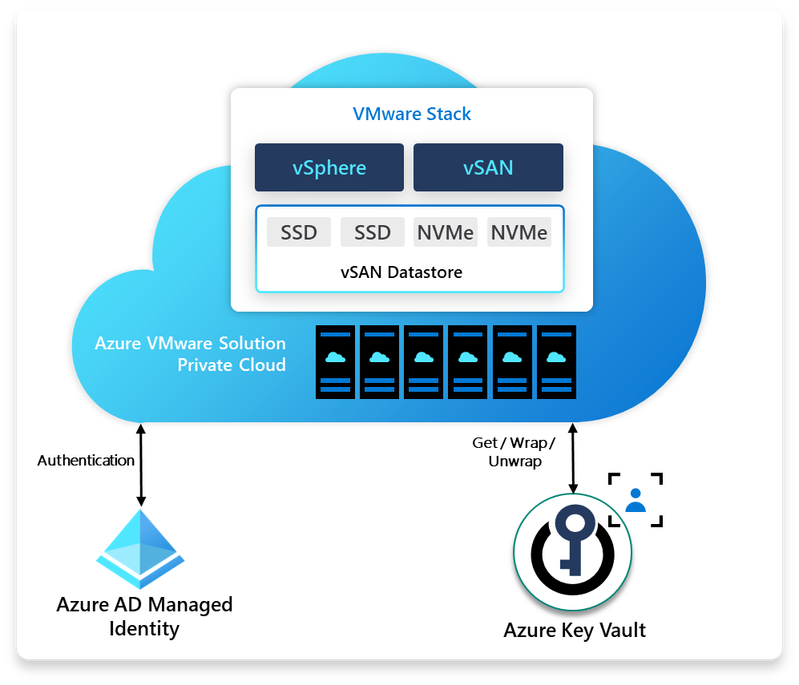Customer Managed Keys for Azure VMware Solution

Azure VMware Solution encryption with customer-managed keys is now Generally Available. Customer-managed keys give customers maximum control over their encrypted vSAN data on Azure VMware Solution. With this feature, customers can use Azure Key Vault to generate customer managed keys and centralize the key management process.
Azure VMware Solution is a VMware validated first party Azure service from Microsoft that provides private clouds containing VMware vSphere clusters built from dedicated bare-metal Azure infrastructure. It enables customers to leverage their existing investments in VMware skills and tools, allowing them to focus on developing and running their VMware-based workloads on Azure.
Azure VMware Solution provides default data at rest encryption for private cloud’s vSAN datastore, and it is performed with service-managed keys, automatically and transparently managed by Microsoft. However, many industries require data that not only encrypted data at rest but do so by using encryption keys that customers have full control over as per regulations and compliance requirement. Customer-managed keys don’t disable default vSAN datastore encryption. Instead, they add a second layer of encryption on top of the default one. This means that customer-managed keys also deliver double encryption, a feature that is sometimes part of the same compliance requirements.
Azure VMware Solution customers need to enable system-assigned managed identity on their private cloud to access keys within customer owned Azure Key Vault. A user with required permission on Azure Key Vault must first grant Get, wrap key, and unwrap key permissions to private cloud managed identity. Customer can revoke access anytime by removing Azure VMware Solution’s access to customer-owned Azure Key Vault or disabling keys used for private cloud encryption, making it impossible for Azure VMware Solution to read or write any data within customer’s private cloud. Moreover, customers can use Azure Key Vault monitoring to ensure only Azure VMware Solution is accessing keys.
Benefits
- Full control of data access via the ability to remove the key and make the private cloud data inaccessible.
- Full control over the key lifecycle, including rotation of the key to aligning with corporate policies.
- Central management and organization of keys in Azure Key Vault
If you are interested in the Customer-managed Key for Azure VMware Solution, please use these resources to learn more about the service:
- How to Doc: Configure customer-managed key encryption at rest in Azure VMware Solution - Azure VMware Solution | Microsoft Learn
- Create Azure Key Vault: Quickstart - Create an Azure Key Vault with the Azure portal | Microsoft Learn
- Configure Networking for Azure Key Vault: How to configure Azure Key Vault networking configuration | Microsoft Learn
- Homepage: Azure VMware Solution | Microsoft Azure
- Learn: Run VMware resources on Azure VMware Solution Training
- Documentation: Azure VMware Solution
Author Bio
Rahi Patel is a Senior Technical Program Manager in the Azure VMware Solution product group at Microsoft. His background is in infrastructure architecture with extensive experience across all facets of the enterprise, public cloud & service provider spaces, including digital transformation and the business, enterprise, and technology architecture stacks.
Published on:
Learn moreRelated posts
Azurite: Build Azure Queues and Functions Locally with C#
Lets say you are a beginner Microsoft Azure developer and you want to : Normally, these tasks require an Azure Subscription. But what if I tol...
Data encryption with customer-managed key (CMK) for Azure Cosmos DB for MongoDB vCore
Built-in security for every configuration Azure Cosmos DB for MongoDB vCore is designed with security as a foundational principle. Regardless ...
Azure Developer CLI: From Dev to Prod with Azure DevOps Pipelines
Building on our previous post about implementing dev-to-prod promotion with GitHub Actions, this follow-up demonstrates the same “build ...
Azure DevOps OAuth Client Secrets Now Shown Only Once
We’re making an important change to how Azure DevOps displays OAuth client secrets to align with industry best practices and improve our overa...
Azure Managed Instance for Apache Cassandra v5.0 Generally Available!
Azure Managed Instance for Apache Cassandra Upgrade to Cassandra v5.0 is now generally available, bringing a host of powerful new features and...
Hunting Living Secrets: Secret Validity Checks Arrive in GitHub Advanced Security for Azure DevOps
If you’ve ever waded through a swamp of secret scanning alerts wondering, “Which of these are actually dangerous right now?”— this enhancement...
Real-Time Security with Continuous Access Evaluation (CAE) comes to Azure DevOps
We’re thrilled to announce that Continuous Access Evaluation (CAE) is now supported on Azure DevOps, bringing a new level of near real-time se...
